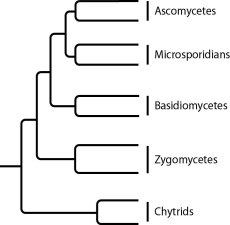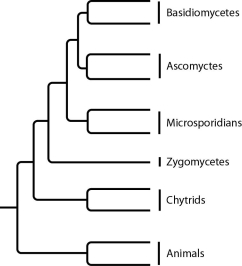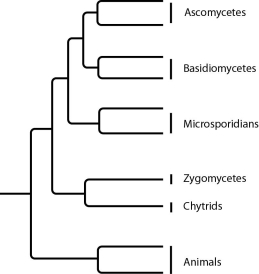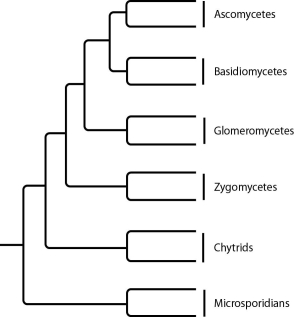A) male gametophyte
B) female gametophyte
C) male sporophyte
D) female sporophyte
F) A) and D)
Correct Answer

verified
Correct Answer
verified
Multiple Choice
The next few questions refer to the following phylogenetic trees.
I.
 II.
II.
 III.
III.
 IV.
IV.
 -Which tree depicts the microsporidians as a sister group of the ascomycetes?
-Which tree depicts the microsporidians as a sister group of the ascomycetes?
A) I
B) II
C) III
D) IV
F) C) and D)
Correct Answer

verified
Correct Answer
verified
Multiple Choice
In terms of alternation of generations, the internal parts of the pollen grains of seed-producing plants are most similar to a
A) moss sporophyte.
B) moss gametophyte bearing both male and female gametangia.
C) fern sporophyte.
D) hermaphroditic fern gametophyte.
E) fern gametophyte bearing only antheridia.
G) A) and C)
Correct Answer

verified
Correct Answer
verified
Multiple Choice
The hydrolytic digestion of which of the following should produce monomers that are aminated (i.e., have an amine group attached) molecules of β-glucose?
A) insect exoskeleton
B) plant cell walls
C) fungal cell walls
D) insect exoskeleton and fungal cell walls
E) insect exoskeleton and plant cell walls
G) D) and E)
Correct Answer

verified
E
Correct Answer
verified
Multiple Choice
How have fruits contributed to the success of angiosperms?
A) by nourishing the plants that make them
B) by facilitating dispersal of seeds
C) by attracting insects to the pollen inside
D) by producing sperm and eggs inside a protective coat
E) by producing triploid cells via double fertilization
G) A) and D)
Correct Answer

verified
Correct Answer
verified
Multiple Choice
Which of the following was not a challenge for survival of the first land plants?
A) sources of water
B) sperm transfer
C) desiccation
D) animal predation
E) lack of sunlight
G) D) and E)
Correct Answer

verified
Correct Answer
verified
Multiple Choice
Please refer to the following information to answer the next few questions. Diploid nuclei of the ascomycete, Neurospora crassa, contain 14 chromosomes. A single diploid cell in an ascus will undergo one round of meiosis, followed in each of the daughter cells by one round of mitosis, producing a total of eight ascospores. -What is the ploidy of a single mature ascospore?
A) haploid
B) diploid
C) triploid
D) tetraploid
E) polyploid
G) C) and D)
Correct Answer

verified
Correct Answer
verified
Multiple Choice
The fruit of the mistletoe, a parasitic angiosperm, is a one-seeded berry. In members of the genus Viscum, the outside of the seed is viscous (sticky) , which permits the seed to adhere to surfaces, such as the branches of host plants or the beaks of birds. What should be expected of the fruit if the viscosity of Viscum seeds is primarily an adaptation for dispersal rather than an adaptation for infecting host plant tissues?
A) It should be drab in color.
B) It should be colored so as to provide it with camouflage.
C) It should be nutritious.
D) It should secrete enzymes that can digest bark.
E) It should contain chemicals that cause birds to fly to the ground and vomit.
G) None of the above
Correct Answer

verified
Correct Answer
verified
Multiple Choice
People who attempted to plant Brazil nuts in hopes of establishing plantations of Brazil nut trees played roles most similar to those of
A) agoutis.
B) orchid bees.
C) pollen tubes.
D) harpy eagles.
F) A) and B)
Correct Answer

verified
Correct Answer
verified
Multiple Choice
In onions (Allium) , cells of the sporophyte have 16 chromosomes within each nucleus. Match the number of chromosomes present in each of the following onion tissues. -How many chromosomes should be in a megasporangium nucleus?
A) 4
B) 8
C) 16
D) 24
E) 32
G) A) and C)
Correct Answer

verified
Correct Answer
verified
Multiple Choice
The next few questions refer to the following description. The cycads, a mostly tropical phylum of gymnosperms, evolved about 300 million years ago and were dominant forms during the Age of the Dinosaurs. Though their sperm are flagellated, their ovules are pollinated by beetles. These beetles get nutrition (they eat pollen) and shelter from the microsporophylls. Upon visiting megasporophylls, the beetles transfer pollen to the exposed ovules. In cycads, pollen cones and seed cones are borne on different plants. Cycads synthesize neurotoxins, especially in the seeds, that are effective against most animals, including humans. -If the beetles survive by consuming cycad pollen, then whether the beetles should be considered mutualists with, or parasites of, the cycads depends upon
A) the extent to which their overall activities affect cycad reproduction.
B) the extent to which the beetles are affected by the neurotoxins.
C) the extent to which the beetles damage the cycad flowers.
D) the distance the beetles must travel between cycad microsporophylls and cycad megasporophylls.
F) A) and C)
Correct Answer

verified
Correct Answer
verified
Multiple Choice
Fossil fungi date back to the origin and early evolution of plants. What combination of environmental and morphological change is similar in the evolution of both fungi and plants?
A) presence of "coal forests" and change in mode of nutrition
B) periods of drought and presence of filamentous body shape
C) predominance in swamps and presence of cellulose in cell walls
D) colonization of land and loss of flagellated cells
E) continental drift and mode of spore dispersal
G) A) and C)
Correct Answer

verified
Correct Answer
verified
Multiple Choice
The next few questions refer to the following phylogenetic trees.
I.
 II.
II.
 III.
III.
 IV.
IV.
 -Which tree depicts the closest relationship between zygomycetes and chytrids?
-Which tree depicts the closest relationship between zygomycetes and chytrids?
A) I
B) II
C) III
D) IV
F) A) and C)
Correct Answer

verified
Correct Answer
verified
Multiple Choice
In seed plants, which of the following is part of a pollen grain and has a function most like that of the seed coat?
A) sporophyll
B) male gametophyte
C) sporopollenin
D) stigma
E) sporangium
G) C) and D)
Correct Answer

verified
Correct Answer
verified
Multiple Choice
The adaptive advantage associated with the filamentous nature of fungal mycelia is primarily related to
A) the ability to form haustoria and parasitize other organisms.
B) avoiding sexual reproduction until the environment changes.
C) the potential to inhabit almost all terrestrial habitats.
D) the increased probability of contact between different mating types.
E) an extensive surface area well suited for invasive growth and absorptive nutrition.
G) C) and D)
Correct Answer

verified
Correct Answer
verified
Multiple Choice
Immediately after karyogamy occurs, which term applies?
A) plasmogamy
B) heterokaryotic
C) dikaryotic
D) diploid
F) C) and D)
Correct Answer

verified
Correct Answer
verified
Multiple Choice
Assuming that they all belong to the same plant, arrange the following structures from largest to smallest (or from most inclusive to least inclusive) . 1. spores 2) sporophylls 3) sporophytes 4) sporangia
A) 2, 4, 3, 1
B) 2, 3, 4, 1
C) 3, 1, 4, 2
D) 3, 4, 2, 1
E) 3, 2, 4, 1
G) C) and E)
Correct Answer

verified
Correct Answer
verified
Multiple Choice
Which of the following is a true statement about plant reproduction?
A) Embryophytes are small because they are in an early developmental stage.
B) Both male and female bryophytes produce gametangia.
C) Gametangia protect gametes from excess water.
D) Eggs and sperm of bryophytes swim toward one another.
E) Bryophytes are limited to asexual reproduction.
G) D) and E)
Correct Answer

verified
Correct Answer
verified
Multiple Choice
Which of the following sex and generation combinations most directly produces the integument of a pine seed?
A) male gametophyte
B) female gametophyte
C) male sporophyte
D) female sporophyte
F) A) and B)
Correct Answer

verified
D
Correct Answer
verified
Multiple Choice
Which of the following can be found in gymnosperms?
A) nonfertile flower parts
B) triploid endosperm
C) fruits
D) pollen
E) carpels
G) B) and E)
Correct Answer

verified
D
Correct Answer
verified
Showing 1 - 20 of 153
Related Exams